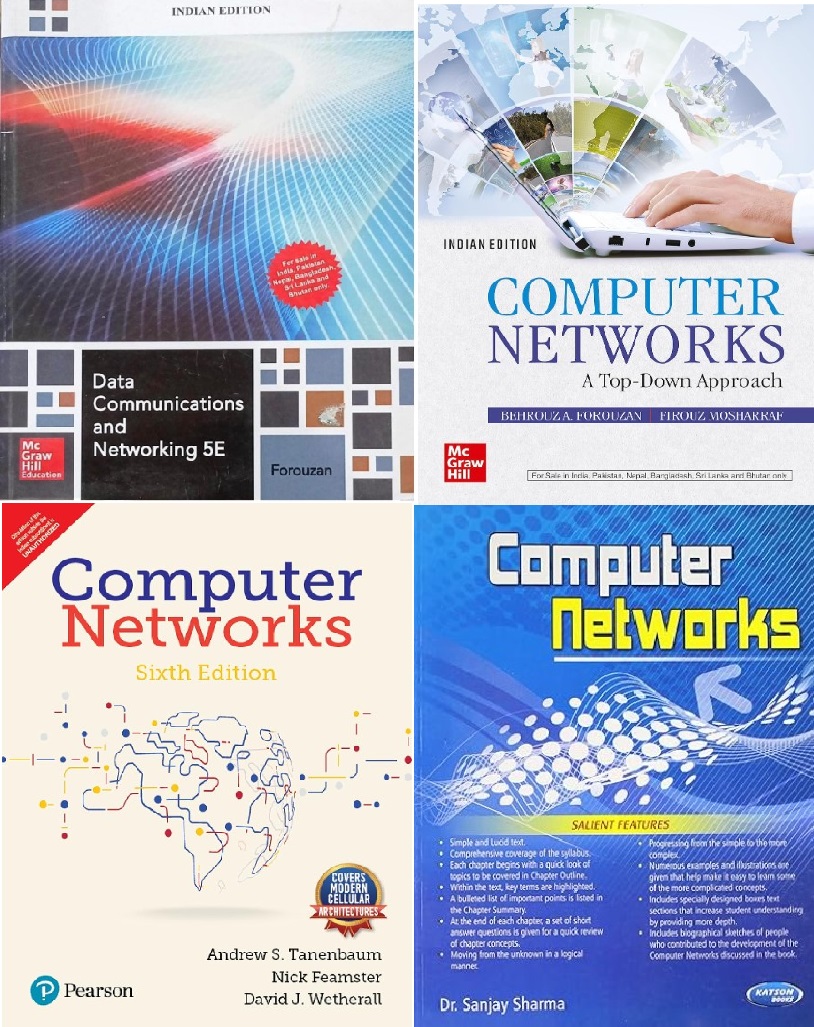Unit 1
Introduction to Data Communication Definition: Effectiveness, Basic Communication Components. Network Architecture Definition, History, Criteria, Goals and Applications of Networks, Categories of networks, Organization of the Internet, ISP, Protocols and standards, The OSI reference model, TCP/IP protocol suite, Network devices and components. Network topology design, Types of connections.
Q61 – The ____ created a model called the Open Systems Interconnection, which allows diverse systems to communicate.
OSI
ISO
IEEE
none of the above
Ans – (2)
Explanation – The model called the Open Systems Interconnection (OSI), which allows diverse systems to communicate, was created by the International Organization for Standardization (ISO).
Q62 – The size and format of physical addresses vary depending on the
Receiver
Message
Sender
Network
Ans – (4)
Explanation – The size and format of physical addresses, such as MAC (Media Access Control) addresses, depend on the type of network technology being used.
Different network technologies (like Ethernet, Wi-Fi, etc.) have different specifications for how physical addresses are structured and their sizes.
For instance, an Ethernet MAC address is 48 bits long, typically represented as 12 hexadecimal digits.
Q63 – The _______ layer links the network support layers and the user support layers in TCP/IP model.
Transport
Network
Data link
Session
Ans – (1)
Explanation – The layer that links the network support layers and the user support layers is the transport layer.
The transport layer is responsible for providing end-to-end communication services between applications on different devices. It ensures that data is delivered reliably and in the correct order, regardless of the underlying network infrastructure.
Q64 – The trailer is added only at
Physical Layer
Data Link Layer
Transport Layer
Network Layer
Ans – (2)
Explanation – In networking, a trailer is added to data units at the Data Link Layer.
The trailer typically contains error-checking information to ensure that the data has not been corrupted during transmission. This process is part of creating a data frame, which is used for reliable data transfer across the physical network.
Q65 – Port address is also known as
Service point address
Receiver point address
Sender point address
Both b and c
Ans – (1)
Explanation – In networking, a port address is often referred to as a service point address. This is because it specifies a particular service or process on a host, allowing different applications or services on the same device to be distinguished from one another.
Q66 – In encapsulation, the data portion of a packet at level N – 1 carries the whole packet from level
N
N+1
N+2
N+3
Ans – (1)
Explanation – This means that the data from the higher layer N is encapsulated within the payload of the packet at level N−1, allowing it to be transmitted across the network.
Q67 – The seven-layer _____ model provides guidelines for the development of universally compatible networking protocols.
OSI
ISO
IEEE
none of the above
Ans – (1)
Explanation –
The seven-layer OSI (Open Systems Interconnection) model is a conceptual framework used to understand and implement networking protocols in seven distinct layers. Each layer has a specific function, ensuring that different networking systems can communicate with each other.
Q68 – TCP/IP model was developed _____ the OSI model.
prior to
after
simultaneous to
none of the mentioned
Ans – (1)
Explanation – The TCP/IP model was developed prior to the OSI model. TCP/IP was initially developed in the 1970s, while the OSI model was developed later, in the late 1970s and early 1980s.
Q69 – Identify the statement which cannot be associated with OSI model
A structured way to discuss and easier update system components
One layer may duplicate lower layer functionality
Functionality at one layer no way requires information from another layer
None
Ans – (3)
Explanation – In the OSI model, layers often interact with each other, and the functionality at one layer may indeed require information from another layer.
This interaction and dependency between layers are fundamental to how the OSI model operates. Therefore, option 3 is not accurate in the context of the OSI model.
Q70 – A 16-bit port address represents
One single number
Four chunks of numbers
Two numbers
Both b and c
Ans – (1)
Explanation – A 16-bit port address represents a single number.
In networking, a port address is typically represented by a 16-bit number, which identifies a specific endpoint or service on a host device. This single number allows for communication between different processes or services running on the same device.
Q71 – The session, presentation, and application layers are the ____ support layers.
user
network
both (a) and (b)
neither (a) nor (b)
Ans – (1)
Explanation – The session, presentation, and application layers are the user support layers.
These layers provide services directly to end-users or applications, facilitating tasks such as session management, data formatting, encryption, and providing user interfaces.
Q72 – The physical, data link, and network layers are the ______ support layers.
user
network
both (a) and (b)
neither (a) nor (b)
Ans – (2)
Explanation –
The physical, data link, and network layers are the network support layers.
These layers are responsible for managing the transmission of data across networks, including tasks such as encoding, error detection, addressing, routing, and forwarding.
Q73 – Why was the OSI model developed?
Manufacturers disliked the TCP/IP protocol suite
The rate of data transfer was increasing exponentially
Standards were needed to allow any two systems to communicate
None of the above
Ans – (3)
Explanation –
The OSI model was developed because standards were needed to allow any two systems to communicate.
Before the OSI model, different manufacturers used their own protocols, which often could not work together.
The OSI model provides a universal set of standards to ensure compatibility and interoperability between different networking systems and devices.
Q74 – The processes on each machine that communicate at a given layer are called
UDP process
Intranet process
Server technology
Peer-peer process
Ans – (4)
Explanation –
The processes on each machine that communicate at a given layer of the OSI model are called peer-to-peer processes. These processes interact with the corresponding layer on another machine to ensure the proper transmission and reception of data.
Q75 – In OSI model dialogue control and token management are responsibilities of?
Session Layer
Network layer
Transport layer
Data link layer
Ans – (1)
Explanation – In the OSI model, dialogue control and token management are responsibilities of the Session Layer. The Session Layer manages and controls the connections (sessions) between computers, including establishing, maintaining, and terminating sessions, as well as coordinating communication and managing tokens to control access to the resources.
Q76 – Which of the following statement is incorrect?
The second layer of communication is the data-link layer
Errors in the physical layer can be detected by the data link layer
The fourth layer, in reference to the OSI model, is the session layer
The CCITT Recommendation X.25 specifies three layers of communication: physical, link and network
Ans – (2)
Explanation –
In the OSI model, the fourth layer is actually the transport layer, not the session layer. The session layer is the fifth layer in the OSI model.
Q77 – Which of the following layer is not network support layer?
Transport Layer
Network Layers
Data link Layer
Physical Layer
Ans – (1)
Explanation –
The Transport Layer is not considered a network support layer in the OSI model.
Instead, it is responsible for end-to-end communication between hosts and provides services such as error detection and correction, flow control, and segmentation.
Q78 – This OSI layer divides a file into segments that are an efficient size for routing.
Session Layer
Physical Layer
Application Layer
Transport layer
Ans – (4)
Explanation –
The OSI layer that divides a file into segments that are an efficient size for routing is the Transport layer.
This layer segments data from the higher layers into smaller units called segments or packets, which are suitable for transmission over the network. These segments are then transmitted individually and reassembled at the receiving end.
Q79 – In computer networking, TCP/IP model also known as
XYZ model
Network model
OSI model
DOD model
Ans – (4)
In computer networking, the TCP/IP model is also known as the DOD (Department of Defense) model. This is because the development of the TCP/IP protocols was funded by the U.S. Department of Defense.
Q80 – Internet Layer in TCP/IP is ……………….
Connection Oriented
Can be Connection Oriented and connection less
Connection less
Client Server type request
Ans – (3)
Explanation –
The Internet Layer in the TCP/IP model is primarily associated with connectionless communication.
It handles the routing of packets across different networks to ensure they reach their destination.
Unlike connection-oriented protocols, which establish a dedicated connection before data transmission, the Internet Layer (also known as the Network Layer) operates independently of such connections.



